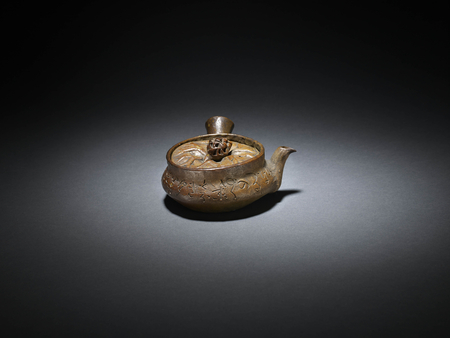Product Description
7119 A pottery teapot the lid with a pine cone finial and the body incised with a poem
Lid interior signed: Rengetsu
Japan 19th century Edo/Meiji period
Dimensions: W.4¾” x H.2″ (12 cm x 4.5 cm)
Inscribed:
Hinazuru no yukusue tōki koe kike ba miyo wo chitose to utau nari keri
(As I listen to the fledgling crane with its long future, it sings: ‘The rein of the Emperor will last forever’.)
Tomobako (original box) inscribed:
Lid: Rengetsu rōni saku, ko kyōsu ichi (Made by the old nun Rengetsu, a small tea pot, one item.)
Lid interior: Uta Hinazuru no yukusue un’nun. Jinko-in nushi, Koen kore wo mitomu (A poem about a young crane’s future, authenticated by (Priest) *Kōen, of the Jinkōin temple)
Seal: Kōen
*Tokuda Koen (b.1935) was the head Priest of Jinkō-in Temple and was the chief authenticator of Rengetsu’s works in modern times.
Otagaki Rengetsu (1791-1875). Rengetsu was in her lifetime a Buddhist nun, poet, calligrapher, potter and painter. Shortly after her birth in Kyoto to a samurai family with the surname Todo, she was adopted by Otagaki Mitsuhisa who worked at Chion’in, an important Jōdo (Pure Land) sect temple in Kyoto, and was given the name Nobu.
In 1798, having lost her mother and brother, she was sent to serve as a lady-in-waiting at Kameoka Castle in Tanba, where she studied poetry, calligraphy and martial arts, returning home at the age of 16 to marry a young samurai named Mochihisa. They had three children, all of whom died shortly after birth; in 1815 Mochihisa also died.
In 1819 Nobu remarried, but her second husband died in 1823. After enduring the tragic loss of two husbands and all her children, Nobu, only 33 years old, shaved her head and became a nun, at which time she adopted the name Rengetsu (Lotus Moon). She lived with her stepfather, who had also taken vows, near Chion’in. After his death in 1832 Rengetsu began to make pottery, which she then inscribed with her own waka (31-syllable classical poetry) and sold to support herself.
In 1875, having led a long and exceptional life, Rengetsu died in the simple Jinkōin tearoom in Kyoto where she had lived and worked for ten years. Jinkōin Temple is a Shingon School temple (Esoteric Buddhism); Rengetsu was ordained as a nun in the Pure Land School (Jōdo Shū) but she also studied and practiced Zen and Esoteric Buddhism.
The delicate hand-built tea utensils that Rengetsu inscribed with hauntingly beautiful poems are unique combinations of poetry, calligraphy and pottery; they were as highly prized in her own lifetime as they are now. Rengetsu is also known to have inscribed her poems on utensils made by other Kyoto potters. In addition to ceramics, she also produced numerous gassaku (jointly created artworks) in the form of paintings, hanging scrolls, and calligraphic works with fellow literati artists and writers.
Works by Rengetsu can be found in the collections of: The Tokyo National Museum and the Michigan Museum of Art and the National Gallery of Australia
For similar teapot in the collection of the National Gallery of Australia see: Black Robe White Mist, art of the Japanese Buddhist nun Rengetsu, p. 65, pl. 79.








